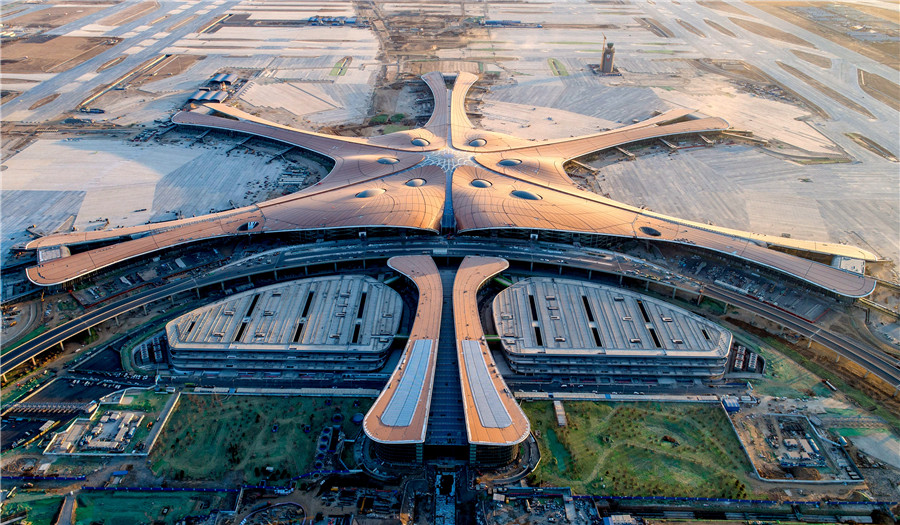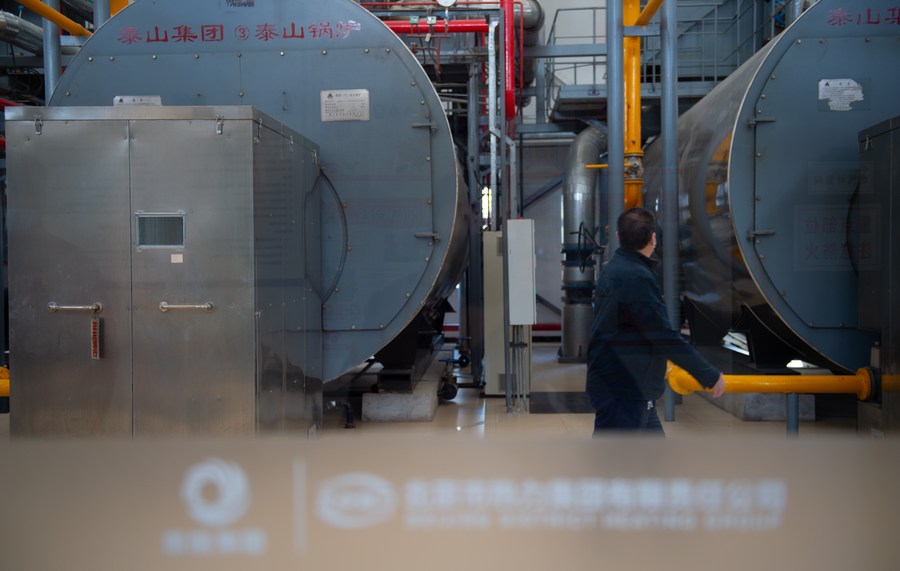Lawmakers and political advisers in Beijing convened last week. Heading their agenda was to review a draft of economic and social development targets for the 14th Five Year Plan period starting this year and a long-range objectives through 2035. Beijing will entrench its position as an significant hub of international exchanges, innovation and spearhead of tackling air pollution, according to the documents.
A world class airport cluster
During the 14th Five Year Plan period, Beijing will promote the construction of a world-class airport cluster, and one of the important tasks is to accelerate the construction of the satellite terminal and supporting projects of the Daxing International Airport.

A bird's-eye view of Beijing Daxing International Airport.(File photo: China Daily)
Satellite terminals are usually seen in hub airports with a large number of transit passengers. Daxing airport will see its satellite terminal finished in 2022. Once completed, the annual passenger throughput of the airport will increase from 45 million to 72 million.
The satellite terminal is located 667 meters south of the airport’s main terminals. It will not only facilitate passengers to travel to and from the main terminal building, but also connect the two intercity rail lines linking the capital with neighboring Tianjin and Hebei Province.
The Beijing government said it will optimize the current regional route network to form a synergy. Hebei and Tianjin will rely on the two airport hubs in Beijing to serve as international gateways, while their own airports mainly serving domestic needs. The cooperation between airports can expand the service scope of the airport cluster, said Guo Jifu, Dean of Beijing Transportation Development Research Institute.
An innovation center
The central government designated the scientific innovation center as one of Beijing’s core functions as the national capital. By 2025, Beijing aims to increase the proportion of advanced and sophisticated industries in its GDP from the current 25.8 percent to more than 30 percent, said the draft.
Beijing is capable of delivering the target, as it’s one of the regions with the strongest scientific and technological foundations, the most concentrated innovation resources and the most active innovation bodies in China, Li Meng, vice-minister of science and technology, said at a press conference last week.
Beijing has more than 90 universities, more than 1,000 scientific research institutes and nearly 30,000 national high-tech enterprises. Meanwhile, there are 128 state key laboratories, and more than 300 technological enterprises are established every day.

A staff member shows a photonic AI chip during a press preview of the 2018 National Mass Innovation and Entrepreneurship Week in Beijing, capital of China, Oct 8, 2018.(File photo: Xinhua)
In the past five years, Beijing’s innovation capacity has been further enhanced, making a number of world-class original achievements, such as quantum computers, new gene editing technology and the Tianjic chip, a breakthrough described by the science journal Nature that helps bridge machine learning and neuroscience.
In the next five years, Beijing will continue to focus on the development of the new-generation information technology, medical and health industries. Beijing plans to foster a trillion-yuan level new generation of information technology industrial clusters, focusing on basic fields such as 5G, artificial intelligence, big data, cloud computing, Internet of Things, and blockchain, and cultivate a batch of enterprises with core technology dominance.
To break bottlenecks, Beijing will promote the research and development of integrated circuits and new materials, accelerate the research process of technologies and products in fields such as third-generation semiconductors, and focus on core technologies in important fields.
One Microgram plan for air quality
Beijing proposed that it would continue to deepen the One Microgram action plan, aiming to clear heavy pollution weather during next five years. The campaign underscores the increasing difficulty of reducing fine particulate matter (PM2.5) density by even a single microgram, even though the capital has witnessed more blue skies in recent years.
According to the latest official data released in early January, the city’s average annual concentration of PM2.5 in the atmosphere dropped to record low 38 micrograms per cubic meter. In 2020, Beijing experienced 276 days of good or moderate air quality, an increase of 36 days over the previous year, with a good or moderate rate of 75.4 percent.

A member of staff is on patrol inspection at the boiler room of a heating service station in Wangjing, Chaoyang District of Beijing, capital of China, Dec. 29, 2020.(File photo: Xinhua)
Analysts credited a cleaner energy structure as a key driver of the continuous improvement of air quality over the past two decades. Wang Jinnan, deputy dean of the Environmental Planning Institute of the Ministry of Ecology and Environment, said that as Beijing implemented the policies to phase out coal consumption, so air pollution caused by coal burning had been greatly reduced.
Winter is a period of high incidence of polluted weather in Beijing, and heating coal is one of the most important sources of air pollutants. In recent years, natural gas has replaced coal as the most consumed fuel for heating in Beijing. In this heating season, clean energy has covered 98 percent of Beijing’s 9 million square meter heating area. A clean and efficient urban heating system has taken shape.
But problems of dust pollution and mobile source air pollution are more prominent. Efforts would be made to deal with them in the future, Wang said.
Beijing strives to control pollution from mobile sources through various policies. It vows to increase the proportion of rail transportation of bulk goods in the next five years. The city will also promote more electric or hydrogen fuel cell vehicles to hit the road. By 2025, the total number of new energy vehicles in the city will reach 2 million.
Beijing has also made ozone control another priority in improving air quality. Compared to PM2.5 control, tackling rising ozone concentrations is still in its infancy in many Chinese cities, including Beijing.
Beijing will implement special control actions focusing on volatile organic compounds (VOCs) in the next five years. Last November, the Beijing environment watchdog said it had arranged cleaner production audits for all companies that emitted more than 10 tons of VOCs a year.
VOCs are important precursors of PM2.5 and ozone in the atmosphere. Formaldehyde, benzene series, and hydrocarbon compounds are all volatile organic compounds, mainly from industrial enterprises that produce or use coatings and solvents. When VOCs are discharged into the atmosphere, PM2.5 and ozone will be produced through chemical reactions, causing serious air pollution.
(Compiled by Liu Kechen and Chen Lidan)


